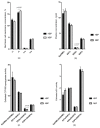Possible Role of CYP450 Generated Omega-3/Omega-6 PUFA Metabolites in the Modulation of Blood Pressure and Vascular Function in Obese Children
- PMID: 30400671
- PMCID: PMC6267577
- DOI: 10.3390/nu10111689
Possible Role of CYP450 Generated Omega-3/Omega-6 PUFA Metabolites in the Modulation of Blood Pressure and Vascular Function in Obese Children
Abstract
Obesity is often accompanied by metabolic and haemodynamic disorders such as hypertension, even during childhood. Arachidonic acid (AA) is metabolized by cytochrome P450 (CYP450) enzymes to epoxyeicosatrienoic acids (EETs) and 20-hydroxyeicosatetraenoic acid (20-HETE), vasoactive and natriuretic metabolites that contribute to blood pressure (BP) regulation. Eicosapentaenoic acid (EPA) and docosahexaenoic acid (DHA) omega-3 polyunsaturated fatty acids may compete with AA for CYP450-dependent bioactive lipid mediator formation. We aimed at investigating the role of AA, EPA and DHA and their CYP450-dependent metabolites in BP control and vascular function in 66 overweight/obese children. Fatty acid profile moderately correlated with the corresponding CYP450-derived metabolites but their levels did not differ between children with normal BP (NBP) and high BP (HBP), except for higher EPA-derived epoxyeicosatetraenoic acids (EEQs) and their diols in HBP group, in which also the estimated CYP450-epoxygenase activity was higher. In the HBP group, EPA inversely correlated with BP, EEQs inversely correlated both with systolic BP and carotid Intima-Media Thickness (cIMT). The DHA-derived epoxydocosapentaenoic acids (EDPs) were inversely correlated with diastolic BP. Omega-3 derived epoxymetabolites appeared beneficially associated with BP and vascular structure/function only in obese children with HBP. Further investigations are needed to clarify the role of omega-3/omega-6 epoxymetabolites in children's hemodynamics.
Keywords: CYP450 eicosanoids; EEQs; EETs; blood pressure; children; hemodynamics; omega-3 PUFA; omega-6 PUFA.
Conflict of interest statement
The authors declare no conflict of interest.
Figures



References
-
- Maffeis C., Pinelli L., Schutz Y. Fat intake and adiposity in 8 to 11 year-old obese children. Int. J. Obes. 1996;20:170–174. - PubMed
-
- . Dietary supplementation with n-3 polyunsaturated fatty acids and vitamin E after myocardial infarction: Results of the GISSI-Prevenzione trial. Gruppo Italiano per lo Studio della Sopravvivenza nell’Infarto miocardico. Lancet. 1999;354:447–455. - PubMed
MeSH terms
Substances
Grants and funding
LinkOut - more resources
Full Text Sources
Medical
Research Materials
Miscellaneous

